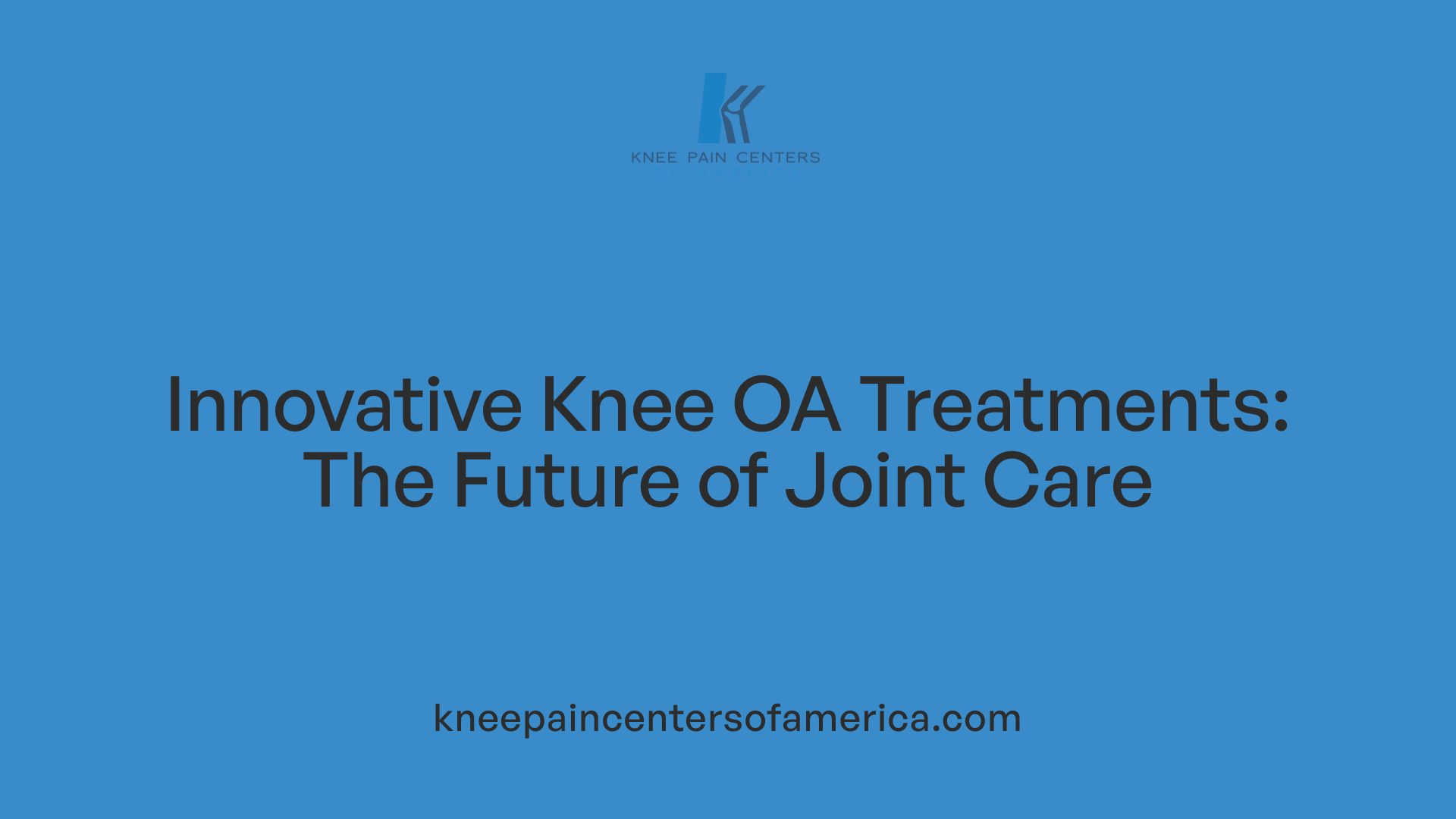Vitamin D and Osteoarthritis: An Underexplored Connection
Osteoarthritis (OA) of the knee is a pervasive condition that significantly impacts mobility and quality of life, especially among older adults. While traditional treatments focus on managing pain and improving joint function, emerging research highlights the influence of vitamin D levels on OA symptoms and progression. This article delves into how vitamin D deficiency may affect knee osteoarthritis, examining clinical studies, therapeutic implications, and potential sex-specific responses to supplementation.
Understanding Knee Osteoarthritis and Common Treatment Modalities
Basics of knee osteoarthritis
Knee osteoarthritis (OA) is a degenerative joint disease characterized by the breakdown of cartilage, leading to pain, stiffness, and impaired function. It commonly affects older adults and is influenced by factors such as age, body weight, and joint injury. Symptoms often include knee pain, reduced mobility, and swelling, which can worsen over time, impacting quality of life.
What are the common medical treatments for knee pain and osteoarthritis?
Several treatment approaches aim to reduce pain and improve knee function in osteoarthritis patients. Medications like acetaminophen and nonsteroidal anti-inflammatory drugs (NSAIDs) are frequently used to alleviate pain and inflammation. Corticosteroid injections into the knee joint can provide temporary relief, while hyaluronic acid injections help lubricate the joint.
Supportive therapies play a vital role in managing symptoms. Physical therapy and occupational therapy focus on strengthening muscles around the knee and improving joint mechanics. The use of braces, shoe inserts, or assistive devices such as canes can reduce joint stress and aid mobility.
Lifestyle changes are important for long-term management. Weight management helps decrease load on the knee joint, and engaging in low-impact exercises like walking, cycling, or water aerobics can maintain joint flexibility and muscle strength without exacerbating pain.
Diagnostic tools such as X-rays and MRI scans assist in evaluating joint damage and disease progression. Blood tests and joint fluid analysis help exclude other conditions that may mimic or accompany knee pain.
When conservative treatments do not provide sufficient relief, surgical options including partial or total knee replacement may be considered to restore function and reduce pain.
Role of Non-Surgical Therapies in Managing Knee Osteoarthritis
How do non-surgical therapies help manage osteoarthritis in the knee?
Non-surgical therapies for knee osteoarthritis focus on reducing pain, improving joint function, and slowing disease progression. Physical therapy and tailored exercise strengthen muscles around the knee, which stabilizes the joint and reduces stress on damaged areas. Supportive devices like knee braces help redistribute joint forces, reducing discomfort during movement.
Intra-articular injections, such as corticosteroids, provide short-term relief by decreasing inflammation inside the joint. Hyaluronic acid injections improve joint lubrication, enhancing mobility and easing stiffness.
Weight management plays a crucial role; losing excess weight reduces mechanical stress on the knee, which alleviates pain and improves function. Low-impact aerobic exercises further support joint health without causing harm.
Moreover, vitamin D supplementation shows promise in symptom management, especially with doses above 2000 IU daily. Vitamin D helps improve pain and physical function scores (WOMAC) but does not significantly affect joint stiffness or cartilage volume. Its benefits appear more pronounced in males, potentially due to vitamin D's role in calcium homeostasis, bone metabolism, and anti-inflammatory effects. Maintaining sufficient serum vitamin D levels over periods of years has been associated with modest improvements in symptoms without increasing adverse events.
Overall, combining these non-surgical approaches helps manage osteoarthritis symptoms effectively, enhancing patients’ quality of life and functional capabilities without requiring surgery.
Surgical Interventions for Severe Knee Osteoarthritis
What surgical options are available for patients with severe knee osteoarthritis?
For patients suffering from severe knee osteoarthritis, several surgical options are available to alleviate pain and improve joint function. The most common surgical treatments include:
- Total Knee Replacement (TKR): This procedure involves replacing the damaged knee joint surfaces with artificial implants, offering significant pain relief and improved mobility.
- Partial Knee Replacement: Suitable for cases where damage is confined to a single compartment of the knee, this surgery replaces only the affected part, preserving more natural knee function.
- Arthroscopic Surgery: A minimally invasive approach to remove loose cartilage, bone spurs, or debris that contribute to pain and restricted movement.
- Osteotomy: This surgery realigns the knee joint by cutting and repositioning the bone, often recommended for younger or more active patients to delay joint replacement.
Indications for Surgery
Surgery is usually considered when:
- Conservative treatments like medication, physical therapy, and injections have failed to provide adequate relief.
- Patients experience severe pain that limits daily activities and quality of life.
- There is significant joint deformity or instability.
- Imaging studies show advanced joint damage.
Types of Procedures
Selection of the appropriate surgical procedure depends on:
| Surgical Procedure |
Description |
Ideal Candidates |
| Total Knee Replacement |
Replacement of entire knee joint surfaces |
Severe arthritis affecting whole knee |
| Partial Knee Replacement |
Replacement of a single damaged compartment |
Localized osteoarthritis |
| Arthroscopic Surgery |
Removal of loose bodies and smoothing joint surfaces |
Mild to moderate joint damage |
| Osteotomy |
Bone realignment to shift weight off damaged areas |
Younger patients with knee misalignment |
The decision for surgical intervention takes into account the extent of joint damage, patient’s activity level, age, and overall health status to optimize outcomes.
Emerging and Innovative Treatments for Knee Osteoarthritis

Are there any emerging treatments or advancements in managing knee osteoarthritis?
Recent years have witnessed promising advances in the treatment options available for knee osteoarthritis (OA), going beyond traditional medications and surgeries.
One noteworthy direction is the development of minimally invasive procedures such as genicular artery embolization (GAE). This technique involves selectively blocking abnormal blood vessels around the knee responsible for inflammation and pain. Patients often experience significant relief within one to two weeks. These procedures are particularly beneficial for those who may not be ideal candidates for surgery due to other health issues.
In parallel, regenerative medicine has emerged as a frontier area aiming to restore joint health. Treatments like stem cell therapy and platelet-rich plasma (PRP) injections are designed to encourage cartilage regeneration and reduce degeneration. While research is ongoing to optimize these therapies, early results show potential for improving pain and joint function.
Further, advancements in rehabilitation are tailoring recovery protocols to each patient's unique condition. Personalized physical therapy regimens, often incorporating technology-assisted monitoring, help enhance mobility, strengthen muscles, and maintain joint integrity.
Together, these innovative approaches present more options that may improve quality of life with fewer risks compared to invasive surgery. As ongoing clinical studies advance, they hold the promise of transforming how knee OA is managed.
Vitamin D’s Biological Role in Joint Health and Osteoarthritis

Vitamin D in Calcium Homeostasis
Vitamin D plays a crucial role in maintaining calcium homeostasis, which is essential for healthy bone and joint function. By promoting calcium absorption in the gut and regulating calcium levels in the blood, vitamin D helps ensure that bones remain strong and resilient. This is particularly important in osteoarthritis (OA), where joint structures are compromised, and adequate calcium levels support the integrity of the subchondral bone beneath the cartilage.
Bone Metabolism
Beyond calcium regulation, vitamin D is integral to bone metabolism. It influences bone remodeling by stimulating osteoblasts (cells that build bone) and moderating osteoclast activity (cells that break down bone). This balanced activity supports bone strength and repair. In knee osteoarthritis, maintaining bone health through sufficient vitamin D levels may help prevent further joint degradation and preserve cartilage by sustaining the underlying bone.
Anti-inflammatory and Cytokine Effects
Vitamin D also exerts anti-inflammatory effects, which are vital in managing osteoarthritis symptoms. It modulates the immune response by regulating cytokine production—cytokines being signaling molecules that can promote inflammation. By reducing pro-inflammatory cytokines and supporting anti-inflammatory pathways, vitamin D may help alleviate joint inflammation, decrease pain, and slow OA progression. These immunomodulatory properties underscore why vitamin D supplementation has been considered a potential therapeutic strategy in OA management.
Together, these biological functions demonstrate how vitamin D supports joint health through ensuring bone strength, regulating inflammatory responses, and facilitating tissue repair mechanisms relevant to osteoarthritis.
Prevalence and Consequences of Vitamin D Deficiency in Older Adults with Knee Osteoarthritis
How common is serum vitamin D deficiency in older adults with knee osteoarthritis?
Serum vitamin D deficiency, often defined as levels below 50 nmol/L (or approximately 20 ng/mL), is highly prevalent among older adults. This deficiency is even more pronounced in patients with knee osteoarthritis (OA). For example, a study including 120 knee OA patients reported mean vitamin D levels of just 13±3.3 ng/mL compared to 32±2.5 ng/mL in healthy controls. Such deficient vitamin D status is linked to impaired joint health and symptom progression.
What impact does vitamin D deficiency have on muscle strength and joint function?
Vitamin D deficiency contributes to decreased muscle strength and worsened joint function, which are critical concerns in OA management. Patients with insufficient vitamin D show poorer joint mobility and increased muscle wasting. This can lead to reduced physical function and a higher risk of falls due to compromised postural balance. Conversely, supplementation with vitamin D has been demonstrated to improve muscle power, reduce fall risk, and enhance overall physical performance.
How is vitamin D deficiency associated with pain and disease severity in knee OA?
Low serum vitamin D levels correlate with increased pain intensity and more severe disease manifestations. In knee OA patients, lower vitamin D was associated with higher scores on the Visual Analog Scale (VAS) for pain and greater impairment measured by the WOMAC index, reflecting joint dysfunction and stiffness. More advanced radiographic OA severity also aligns with decreased vitamin D levels. These findings underscore the importance of maintaining adequate vitamin D to potentially alleviate symptoms and slow disease progression.
Insights from Randomized Controlled Trials on Vitamin D Supplementation in Knee OA

What Have RCTs Revealed About Vitamin D's Effect on Pain, Stiffness, and Function?
Randomized controlled trials (RCTs) investigating vitamin D supplementation in knee osteoarthritis (OA) have produced mixed outcomes. Some trials demonstrated that doses exceeding 2000 IU daily led to significant reductions in WOMAC pain scores and improvements in physical function. However, the impact on WOMAC stiffness was consistently non-significant, suggesting vitamin D's benefit may be symptom-specific. One notable study reported that despite increased serum vitamin D levels after supplementation, clinical symptoms such as pain and stiffness did not improve substantially over the study period.
Does Vitamin D Supplementation Affect Cartilage Volume or Joint Structure?
RCT evidence generally indicates no significant effect of vitamin D on tibial cartilage volume or other structural measures of knee OA, including radiographic joint space width and cartilage thickness. For example, the VIDEO trial, a well-designed double-blind placebo-controlled trial, found no meaningful difference in cartilage loss or joint structure deterioration after two years of vitamin D supplementation aimed at raising serum 25-hydroxyvitamin D levels above 36 ng/mL.
How Do Duration and Dosage Influence Outcomes?
The duration of the studied interventions typically ranged from 2 to 5 years, with some longer-term follow-up data providing insights on sustained vitamin D status and knee OA progression. Although doses over 2000 IU daily appear linked to more pronounced improvements in pain and function, other trials using similar dosages did not achieve significant symptom relief, highlighting variability likely due to patient characteristics or trial design. Notably, vitamin D supplementation was safe with adverse event risks comparable to placebo groups across these studies.
Collectively, RCT data support that while vitamin D raises serum levels reliably, its role in improving knee OA symptoms or slowing structural progression remains uncertain. Further large-scale and longer-duration trials are needed to clarify which patient subgroups may derive meaningful benefit from vitamin D interventions.
Vitamin D Supplementation: Symptom Relief and Safety Profile in Knee OA Patients

How does Vitamin D supplementation affect WOMAC pain and function scores in knee OA patients?
Vitamin D supplementation has been shown to significantly reduce WOMAC pain and improve WOMAC function scores in patients with knee osteoarthritis (OA). Higher doses, specifically those exceeding 2000 IU daily, correlate with greater improvements in these clinical measures. The increase in serum vitamin D3 levels achieved through supplementation is linked to these symptom benefits, particularly in enhancing joint function and alleviating pain.
Does Vitamin D have any effect on stiffness and cartilage volume in knee OA?
Despite its positive effects on pain and function, vitamin D supplementation does not significantly influence WOMAC stiffness scores. Additionally, studies have found no meaningful changes in tibial cartilage volume following vitamin D supplementation. These findings suggest that while vitamin D helps alleviate symptoms, it may not alter structural progression or stiffness related to knee OA.
What is the safety profile of Vitamin D supplementation for knee OA patients?
Vitamin D supplementation exhibits a safety profile comparable to placebo groups. The incidence of adverse events among patients taking vitamin D is similar, indicating it is well tolerated over the course of treatment. This makes vitamin D a safe option for managing symptoms in knee OA without increasing the risk of negative side effects.
Sex-Specific Effects of Vitamin D on Knee Osteoarthritis Pain
How do males and females with knee osteoarthritis respond differently to vitamin D supplementation?
Research shows a distinct difference in how males and females with knee osteoarthritis (KOA) respond to vitamin D supplementation. In males, higher serum vitamin D levels consistently correlate with lower WOMAC pain scores, indicating significant pain reduction. This association remains strong across multiple statistical models, supporting a reliable link between vitamin D and symptom relief in men. Conversely, in females, no significant association was observed between vitamin D levels and KOA pain, suggesting gender-specific biological or hormonal factors influence the therapeutic effects of vitamin D.
What is the relationship between serum vitamin D and pain reduction in KOA patients?
The relationship between serum vitamin D and knee osteoarthritis pain in males exhibits both nonlinear and linear characteristics. Initially, the association appears nonlinear, indicating that pain reduction does not increase proportionally across all vitamin D levels. However, after adjusting for various confounding factors, the relationship becomes linear, with increasing serum vitamin D linked to progressive decreases in pain severity. These findings underscore the potential benefits of maintaining sufficient vitamin D levels in male KOA patients to achieve clinically meaningful symptom improvements.
Why might these sex-specific differences exist?
Potential explanations for these sex-specific effects include differences in hormonal regulation, vitamin D metabolism, and immune responses between males and females. Vitamin D's role in modulating inflammatory cytokines and supporting calcium homeostasis may interact differently with male physiology. Additionally, factors such as body mass index, which affects vitamin D availability due to fat sequestration, and genetic variations may also play roles. These nuances suggest males might benefit more from vitamin D supplementation in terms of pain relief for knee osteoarthritis.
This evidence supports the idea of personalized treatment strategies, emphasizing vitamin D supplementation as a potential therapeutic approach particularly advantageous for male patients with knee osteoarthritis.
Interplay Between Body Mass Index, Vitamin D Deficiency, and Knee Osteoarthritis Pain

How Does Body Mass Index Affect Vitamin D Bioavailability?
Body Mass Index (BMI) notably impacts the bioavailability of vitamin D in individuals. Higher BMI values are linked to increased vitamin D deficiency because vitamin D, being fat-soluble, tends to be sequestered in adipose tissue. This sequestration reduces the circulating levels of vitamin D3 in the serum, limiting its availability to exert physiological effects such as calcium homeostasis and modulation of inflammatory cytokines important in joint health.
What Are the Confounding Effects on Osteoarthritis Pain?
The relationship between vitamin D levels and knee osteoarthritis (KOA) pain is complex and influenced by BMI. Elevated BMI, commonly associated with vitamin D deficiency, may confound the association observed between vitamin D and KOA pain. For example, obesity not only affects vitamin D metabolism but also exacerbates mechanical stress on knee joints, thus contributing independently to pain and disease progression. Consequently, differentiating the direct influence of vitamin D from the mechanical and metabolic effects of high BMI remains a clinical challenge.
What Are the Clinical Implications?
Clinically, understanding the interplay between BMI, vitamin D levels, and KOA pain underscores the importance of a multifactorial approach in patient management. Patients with higher BMI might require targeted vitamin D supplementation strategies to overcome reduced bioavailability. Additionally, weight management could be essential to improve vitamin D status and alleviate KOA symptoms concurrently. This holistic perspective promotes better pain control and functional outcomes in knee osteoarthritis patients.
Long-Term Vitamin D Status and Osteoarthritis Outcomes Over Several Years
Maintaining sufficient vitamin D over 5 years
Long-term maintenance of adequate serum vitamin D levels appears to be linked with better outcomes in patients with knee osteoarthritis (KOA). Research following up on vitamin D supplementation trials for as long as five years shows that patients who sustain sufficient vitamin D levels experience modest benefits in terms of symptom relief and physical function. This sustained vitamin D sufficiency seems to create a more favorable environment for managing KOA symptoms over time.
Modest improvements in pain and function without surgery
Interestingly, in individuals who did not undergo knee surgery during the follow-up period, maintaining adequate vitamin D status over five years was associated with modest improvements in pain reduction and physical function, as measured by the WOMAC index. These improvements also extended to mood, with noted decreases in depression scores. These findings suggest that vitamin D may play a supportive role in symptom management and quality of life in KOA patients, particularly when surgical intervention is not part of their treatment pathway.
Lack of influence on surgical rates
Despite the noted symptomatic benefits, long-term vitamin D supplementation did not translate into a reduction in the incidence of knee surgeries, including total knee replacements, over the five years. This indicates that while vitamin D may help alleviate symptoms and improve function to some degree, it does not seem to affect the structural progression of knee osteoarthritis enough to influence the need for surgical intervention in the longer term.
The evidence points towards vitamin D’s role as a complementary therapy that supports symptom control, especially in maintaining joint function and managing pain over extended periods, but not as a means to delay or prevent surgery in KOA patients.
Vitamin D Deficiency’s Association with Disease Severity and Progression in Knee OA
Correlation with Kellgren-Lawrence Grades
Studies have demonstrated a clear link between low vitamin D levels and increased severity of knee osteoarthritis (OA) as measured by Kellgren-Lawrence (KL) grades. Patients with more advanced OA (higher KL grades) consistently show significantly lower serum vitamin D concentrations. For example, one investigation reported vitamin D levels averaging 13±3.3 ng/mL in knee OA patients compared to 32±2.5 ng/mL in healthy controls, suggesting a strong inverse relationship between vitamin D status and radiographic severity.
Relationships with WOMAC Index and Pain Severity
Vitamin D deficiency also correlates with worsening symptoms assessed via the WOMAC index, a widely used tool quantifying pain, stiffness, and physical function in osteoarthritis. Lower vitamin D levels are associated with higher WOMAC pain scores and poorer function, indicating that deficiency exacerbates both subjective pain and disability. Additionally, patients with deficient vitamin D tend to report greater pain severity on visual analog scale (VAS) assessments, highlighting its role in symptom burden.
Influence on Structural Progression
Evidence on the influence of vitamin D on the structural progression of knee OA presents a complex picture. While epidemiological data suggest vitamin D deficiency may contribute to cartilage degradation and disease advancement, randomized controlled trials have shown mixed outcomes. Some studies report no significant effect of vitamin D supplementation on tibial cartilage volume or radiographic progression over two years, although longer-term maintenance of sufficient vitamin D levels has been linked with modest symptom improvements, particularly in patients without surgical interventions. This suggests that vitamin D status may have a role in modifying progression but is not conclusively protective against structural damage.
In summary, vitamin D deficiency is strongly associated with greater OA severity and symptom burden, making it a relevant factor in disease management and prognosis. Monitoring and addressing deficiency might help mitigate pain and function decline, although its effect on slowing structural progression remains uncertain.
Vitamin D's Role in Enhancing Treatment Outcomes Through Anti-Inflammatory and Tissue Repair Mechanisms
Anti-inflammatory Effects of Vitamin D3
Vitamin D3 supplementation has been shown to exert significant anti-inflammatory effects in patients with knee osteoarthritis. It helps modulate the immune response by regulating the production and activity of inflammatory cytokines, molecules that drive joint inflammation and pain. By reducing pro-inflammatory cytokines and promoting anti-inflammatory ones, vitamin D3 contributes to decreased joint inflammation, potentially lowering pain and improving function.
Modulation of Cytokines
Vitamin D influences the balance of cytokines within joint tissues. It suppresses the expression of inflammatory mediators such as interleukin-6 (IL-6) and tumor necrosis factor-alpha (TNF-α), which are associated with cartilage degradation and synovial inflammation in osteoarthritis. Through this modulation, vitamin D helps protect cartilage from damage and supports a more favorable environment for joint health.
Contribution to Therapies such as Prolotherapy
Beyond direct supplementation, vitamin D plays a supportive role in therapeutic approaches like Prolotherapy, which relies on stimulating tissue regeneration and repair. By enhancing cellular protection and promoting tissue repair mechanisms, adequate vitamin D levels can improve the efficacy of Prolotherapy and similar regenerative treatments. This synergy aids in reducing pain and improving joint function, contributing to better overall treatment outcomes in knee osteoarthritis management.
Quality of Life Improvements in Osteoarthritis Patients Through Vitamin D Supplementation
How does vitamin D supplementation contribute to pain reduction in osteoarthritis patients?
Vitamin D supplementation has been shown to significantly reduce WOMAC pain scores in patients with knee osteoarthritis (KOA). This pain relief is particularly notable in males, where higher serum vitamin D levels strongly correlate with lower pain scores. The anti-inflammatory properties of vitamin D, especially vitamin D3, play a crucial role by modulating cytokine activity, which helps ease joint pain and inflammation. Supplementation over time increases serum vitamin D3 levels, contributing to reduced chronic pain and improved patient comfort.
What effects does vitamin D have on grip strength and muscle function?
In addition to pain reduction, vitamin D supplementation enhances muscle strength, including grip strength. Osteoarthritis patients who experience vitamin D insufficiency often show decreased muscle power and wasting. Supplementation helps reverse these deficits, promoting better muscle function. Improved muscle strength not only supports joint stability but also aids physical function, empowering patients to perform daily activities more effectively.
How does vitamin D improve physical performance and reduce fall risk?
Vitamin D plays a vital role in postural balance, cellular protection, and tissue repair. By reducing muscle weakness and improving joint function, vitamin D supplementation lowers the risk of falls among osteoarthritis patients. Clinical trials have demonstrated improved physical performance with vitamin D2 and D3 supplementation, including better mobility and enhanced quality of life. Maintaining sufficient vitamin D levels over extended periods supports sustained improvements in physical function, which are critical for preventing disability and enhancing independence.
Overall, vitamin D supplementation offers multifaceted benefits that contribute to improved quality of life in osteoarthritis patients. Pain reduction, enhanced muscle strength, and better balance combine to support daily living and reduce complications associated with KOA.
Summary of Scientific Uncertainties and Need for Further Research on Vitamin D in Knee OA
Mixed results from clinical trials
Clinical trials investigating vitamin D supplementation in knee osteoarthritis (OA) have reported varied outcomes. Some randomized controlled trials (RCTs), such as the VIDEO trial, found no significant improvements in knee pain, cartilage volume, or joint space narrowing after two years of supplementation despite increased serum vitamin D levels. Other studies have demonstrated modest benefits, including reduced WOMAC pain and improved physical function in certain patient groups. These inconsistencies highlight that vitamin D's role in managing knee OA symptoms remains inconclusive.
Need for longitudinal and randomized studies
Longer-term research is essential to understand the therapeutic potential of vitamin D in knee OA fully. While short-term supplementation has shown limited effects, some evidence suggests that maintaining adequate serum vitamin D levels over five years may modestly reduce pain and physical dysfunction in patients who have not undergone knee surgery. Future randomized and longitudinal studies with larger sample sizes are needed to confirm causality, optimal dosing, and patient subgroups who may benefit the most.
Potential for sex-specific therapeutic approaches
Emerging data indicate possible sex differences in response to vitamin D supplementation. Studies report a significant association between higher serum vitamin D levels and pain reduction primarily in males with knee OA, whereas females show no such correlation. This suggests vitamin D may have sex-specific therapeutic effects, warranting further investigation into tailored supplementation strategies based on sex to optimize treatment outcomes.
The current body of research supports continuing exploration into vitamin D's anti-inflammatory, bone metabolic, and calcium regulatory roles to clarify its clinical relevance in knee OA management. Careful design of future clinical trials focusing on dosing, duration, sex differences, and patient-specific factors will be critical to unlocking vitamin D's potential benefits for knee osteoarthritis.
Navigating the Complex Relationship Between Vitamin D and Knee Osteoarthritis
While vitamin D deficiency is prevalent among patients with knee osteoarthritis and appears to influence symptom severity and function, clinical trial results on supplementation are mixed. Evidence suggests vitamin D’s role in bone metabolism, inflammation modulation, and possibly tissue repair could benefit OA management, especially in males and those maintaining sufficient levels long-term. However, supplementation does not consistently improve cartilage structure or prevent disease progression, underscoring the need for further targeted research. Integrating vitamin D assessment and supplementation into personalized knee osteoarthritis treatment regimens may enhance outcomes alongside established medical and surgical approaches.
References